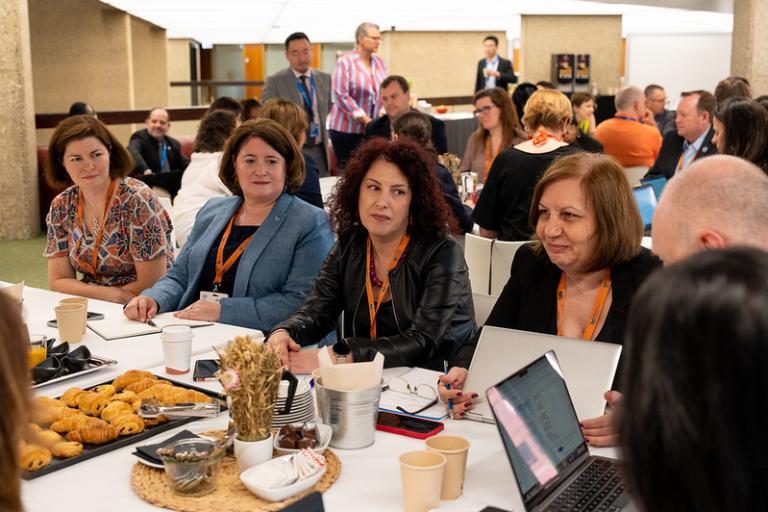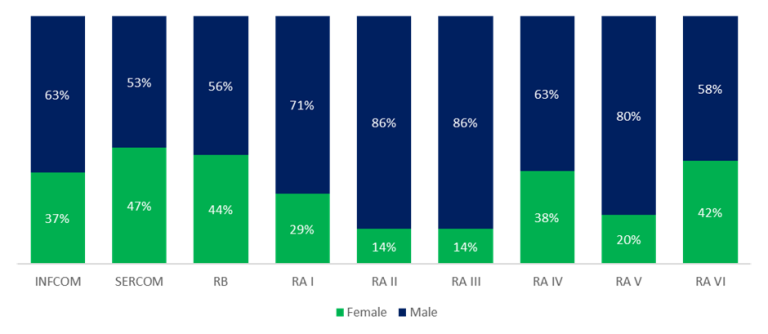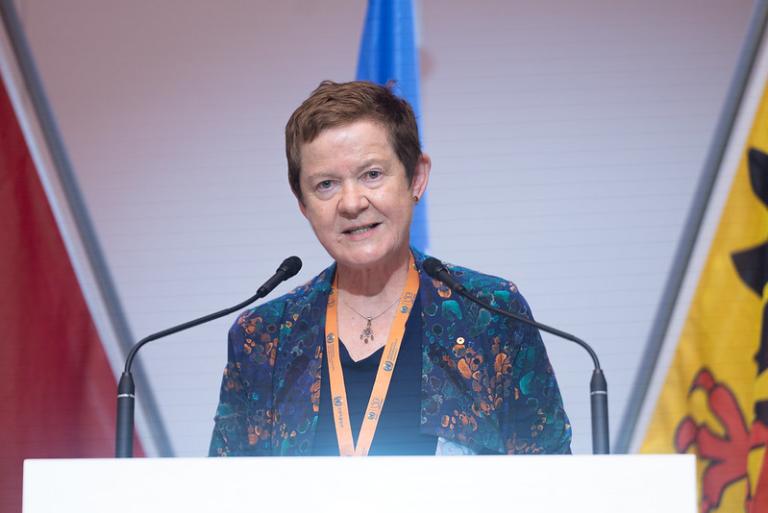WMO Gender Action Plan

Over the last 10 years, WMO has adopted a Gender Action Plan then an Updated Gender Action Plan. Why the push for accelerating the inclusion of women within the Organization as well as in projects and activities on-the-ground? Because the voices of both women and men should contribute to and participate in the development and implementation of climate mitigation and adaptation, early warning services and disaster risk reduction. Women stakeholders, scientists and service providers should have equal seats at the table to their male counterparts. The 2015 WMO Gender Action Plan brought positive change, which the 2023 updated WMO Gender Action Plan aims to accelerate.
The role of women
Women are the usual caretakers of children and elderly family members, guardians of family health and well-being and, frequently, the managers of household resources. Gender equality (SDG5) is, therefore, a cross-cutting issue that has the potential to trigger progress on many of the Goals of the Sustainable Development Agenda (SDGs), most notably in the following:
- Life Below the Sea (SDG14), which supports women’s involvement in ocean observations, science and preservation
- Climate Action (SDG13), which calls for urgent action to combat climate change and its impacts
- Clean Water and Sanitation (SDG6), in most water-scarce regions, it is women who must ensure that their families have clean water
- Good Health and Well-Being (SDG3) in responding to health-related needs of women during and after disasters
- Zero Hunger (SDG2) in increasing women smallholder farmers’ access to and use of agricultural weather information, and others.
Gender equity is especially important for realizing SDG 13's call for Climate Action. Households headed by women have higher rates of poverty, which leave them more vulnerable to the increasing disaster risks from climate change. Gender relations are part of the social and cultural context that shape a community’s ability to anticipate, prepare for, be safe and recover from disasters. It is only by working together that women and men can best identify the hazards and threats to their homes and livelihoods and build safer communities. Women and men will have to work in partnership to build tomorrow’s weather and climate-resilient societies.
To address these issues, WMO is increasing its commitment to gender action and to empowering girls and women, not just as a matter of equity and justice but to meet the challenges of climate change, disaster risk reduction and sustainable development. The equally represented talent, energy and skills of both women and men must be fully unleashed to ensure rapid progress in science and operational services provided by WMO.
A UN Women report in January 2024 stated that “At the current rate, gender equality in the highest positions of power will not be reached for another 130 years.”
Gender Action at WMO
The WMO Gender Action Plan approved by World Meteorological Congress in 2015 accelerated the proportional representation of women in WMO activities. At the previous Congress in 2011, for the first time – some 60 years into WMO history – women led delegations had surpassed the 10% mark: 11% of principals in delegations were women. That figure had risen to 16% in 2015 when the Gender Action Plan was adopted. Two Congress sessions later, in 2023, it was 28%. The overall participation of women in delegations also steeply increased: from 13% in 1999 when it surpassed the 10% mark for the first time, it had jumped to 27% in 2015 then 37% in 2023. The gender curve for Executive Council (EC) membership is slightly flatter: from 14% in 2013 when it surpassed the 10% mark for the first time, it climbed to 26% in 2023. Nonetheless the pace of change was impressive: after taking over half a century to surpass the 10% mark, in less than 20 years women representation had doubled and, in some cases, almost tripled.
After the WMO Reform in 2019, which consolidated the technical constituent bodies of the Organization into the 1) Commission for Weather, Climate, Hydrological, Marine and Related Environmental Services and Applications (SERCOM), 2) the Commission for Observation, Infrastructure and Information Systems (INFCOM) and 3) the Research Board (RB), there was an overall increase of 30% in the participation of women in the new constituent bodies. Figure 1 shows the gender composition of the management groups of the new bodies and of the WMO Regional Associations (RAs) in 2023. SERCOM, the RB and RA VI (Europe) have even surpassed the Gender Action Plan’s minimum target of 40% women, though the figure shows a definite need for accelerated gender action in the constituent bodies.

The Secretariat reports that gender parity has been achieved in lower-level professional positions (P1-P4) but the glass ceiling remains in place: only 29% of senior management are women. Thus, women are underrepresented at all levels of decision-making in the Secretariat and in WMO Members States and Territories.
Thus, Congress approved an updated WMO Gender Action Plan in June 2023, urging the Secretariat to lead this effort through example, capacity development efforts and by nurturing networks of women. The Gender Action Plans aims to accelerate the rate of participation of women in delegates and expert in WMO activities and to encourage women to seek out new roles and experiences at the local, regional and international levels.
Leading by example
Research shows that organizations that respect and value gender equality and diversity attract and retain more talented staff and improve their overall performance. Gender diverse teams bring more varied perspectives to the discussion, produce a more holistic analysis of issues, and spur greater effort, thus leading to improved decision-making. To lead by example, The Secretariat will work with the WMO Staff Association and Human Resources Department to increase the representation of women in its staff by ensuring that job descriptions and contract terms are not gender biased and take gender issues into consideration. The Secretariat will also encourage Members to nominate women experts and to increase the representation of women in delegations for constituent body and regional sessions. Gender balance will be included in the terms of reference, planning and discussions of all constituent bodies, including in their management and working structures, and strategies will be devised to strengthen women expert networks. All programmes and projects under development will be required to integrate gender mainstreaming, including during quality assurance review. The Secretariat will also lead by advocating for strong language on gender equality in resolutions, decisions and statements.
WMO is not calling on every woman to take on a mantle of leadership, but for every woman to have a voice and to contribute in her own way. The presentations, case studies and interviews in the WMO Gender webpage highlight the diverse roles of women in all areas of the weather, climate and water agenda. Every woman may not want to become a WMO Secretary-General, like Professor Celeste Saulo, or an IMO Prize winner, like Sue Barrell and Julia Slingo, but all can contribute in their own way over their careers as you can read in the stories that follow this article.

Many of the stories and interviews that WMO has published reflect the importance of networking and mentorship. A mentor, a supervisor, a teacher or professor, a colleague, a friend – one or several different people were there along the way to give advice, a helping hand or to offer useful guidance. Networking is a source of support, can provide an external point of view for evaluating risks and opportunities and can bring new perspectives that can enable mentees to identify steppingstones and avoid roadblocks. The Secretariat aims to build an effective mentorship programme for staff and to encourage Members to do likewise. Mentorships require an investment of time and effort that is for the future of the Organization, to pass on knowledge and build the leadership.
A WMO Gender Workshop, funded by the Climate Risk and Early Warning Systems (CREWS) before the COVID pandemic, brought early career meteorologists and hydrologists together with the heads of several Pacific-Island meteorological services serves as a good example. The women shared the same social and cultural context that defined their community’s gender relations and its challenges. In the three short days, the Pacific women pulled together with conviviality, exchanging experiences and creating bonds that led several of the women in leadership roles to offer mentorship to their young colleagues. It is such networks that the WMO Gender Action Plan aims to create and foster.
On-the-ground in WMO projects
WMO projects and activities on-the-ground, especially those funded by CREWS, recognize that gender influences the way people access, process and respond to early warnings and information, thus include the empowerment of women as fundamental for building climate resilience. CREWS has adopted gender-sensitive operational procedures to ensure that every project includes budgeted activities that empower the role of women. CREWS recognizes that women’s roles differ from those of men in society, thus women’s contributions to project design, planning and implementation can increase the usefulness of the climate services to a broader segment of society.
Gender also affects the processing and dissemination of understandable warnings as women and men access information differently – for example, through different media, at different times and trust different sources. Women’s involvement in the dissemination of warnings has been shown to increase the number of people receiving the warnings and the safety of family under their care. Many projects include gender workshops for service providers and for women stakeholders in local communities to define their needs and design the services and products they require. This requires concerted effort with WMO project partners, who also strive for gender equity thus have gender best practices from which WMO learns and the projects benefit.
As a result of the adoption of the CREWS gender-sensitive operational procedures, WMO has been able to document a growing number of success stories in building gender-sensitive services. For example, in Mali, 95 women leaders from Bamako and Segou region were trained on climate risks and early warning systems and made strides on setting up a women leaders’ network. In Fiji, a national volunteer scheme for disaster management is being developed to engage and train local people, particularly women, youth and those with disabilities. In Niger, 600 women leaders, trained on early warning and disaster management to build community resilience with knowledge, created WhatsApp groups to share alerts and information – an organic early warning system was born. Success has led to an informal national Women Leaders Network run by civil protection authorities, connecting heads of diverse regional platforms. Information flows both ways as networks work closely with all-level authorities. The latter now rely on the women for timely crisis prevention and response communication among communities.
Looking ahead
Women and men both have a role in bringing about gender equity. It is not a zero-sum game, both benefit. Gender-responsive weather, hydrological and climate services have expanded reach in communities and increase the adaptive capacity of those most affected, and thus have the potential to save more lives, livelihoods and assets. Services that include the gender-differentiated vulnerabilities, capacities and needs of different groups of women and men are both more effective and useful. Equal access and use of weather, hydrological and climate services allows all stakeholders to better understand risks, to anticipate and manage extreme events, to take advantage of favourable conditions, and to adapt to change.


